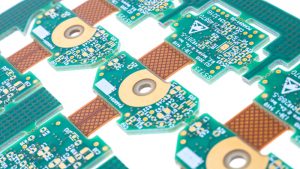Inside the Operations of a Leading Rigid-Flex PCB Manufacturer
Leading Rigid-Flex PCB Manufacturer
Rigid-flex PCBs combine the best of rigid and flexible printed circuit board technology. They are used for applications where both flexibility and space efficiency are necessary, such as medical, aerospace, industrial and automotive electronics. While a standard rigid circuit board may not stand up to the wear and tear of certain industrial environments, combining it with a flexible circuit makes a strong, robust product. Rigid-flex PCBs also reduce the weight and size of the finished product.
Rigid flex fabrication is a multi-step process that starts with the PCB design layout stage. The resulting layout is then submitted to the rigid flex pcb manufacturer who will then prepare the base material for the manufacturing process. The base material is made of rigid sections such as FR-4 and flexible dielectric materials like polyimide or LCP, which are bonded together to form the rigid-flex PCB. Conductive traces are etched on both rigid and flexible layers to route signals between components. Vias and component holes are then plated through the boards using advanced plating techniques.

The next step is to add copper foil to the circuit boards, either by lamination to the adhesive or chemically deposited on top of the seed layer. A pre-bake cycle is then applied to the PCBs, which removes any moisture retained during the manufacturing process. This process is not needed if the PCBs are to be assembled right after manufacture, which is the case for quick turn PCB assembly services.
Inside the Operations of a Leading Rigid-Flex PCB Manufacturer
After the conductive traces have been added to the board, a mask pattern is then applied to the surface of the laminate using photo imaging or screen printing. The resulting etch resist allows the underlying copper to be uncovered and then chemically plated. The copper is deposited through the vias and holes in order to connect all of the rigid and flexible portions of the board.
Once the pads and holes have been plated, they can then be soldered to the appropriate components using solder paste. This step is performed in reflow ovens, which are heated to high temperatures in order to melt and bond the solder to the components. The reflow process is then allowed to cool down in order to complete the soldering process.
Depending on the project requirements, the flex circuit boards can then be cut to their individual sizes using a process called blanking. This can be done with a hydraulic punch and die set, which is the preferred method for high-volume production. However, for prototyping and low-volume production runs, a blanking knife can be used instead.
Using a rigid-flex contract manufacturer who can deliver on their commitments for quick turn production is the most effective way to get your product to market as quickly as possible. A reputable manufacturer with experience working on complex projects will be able to offer you the service and quality that you need, no matter what kind of production run you require. With the help of a quick-turn PCB assembler, you can have your product to market before the competition even knows that it is there!